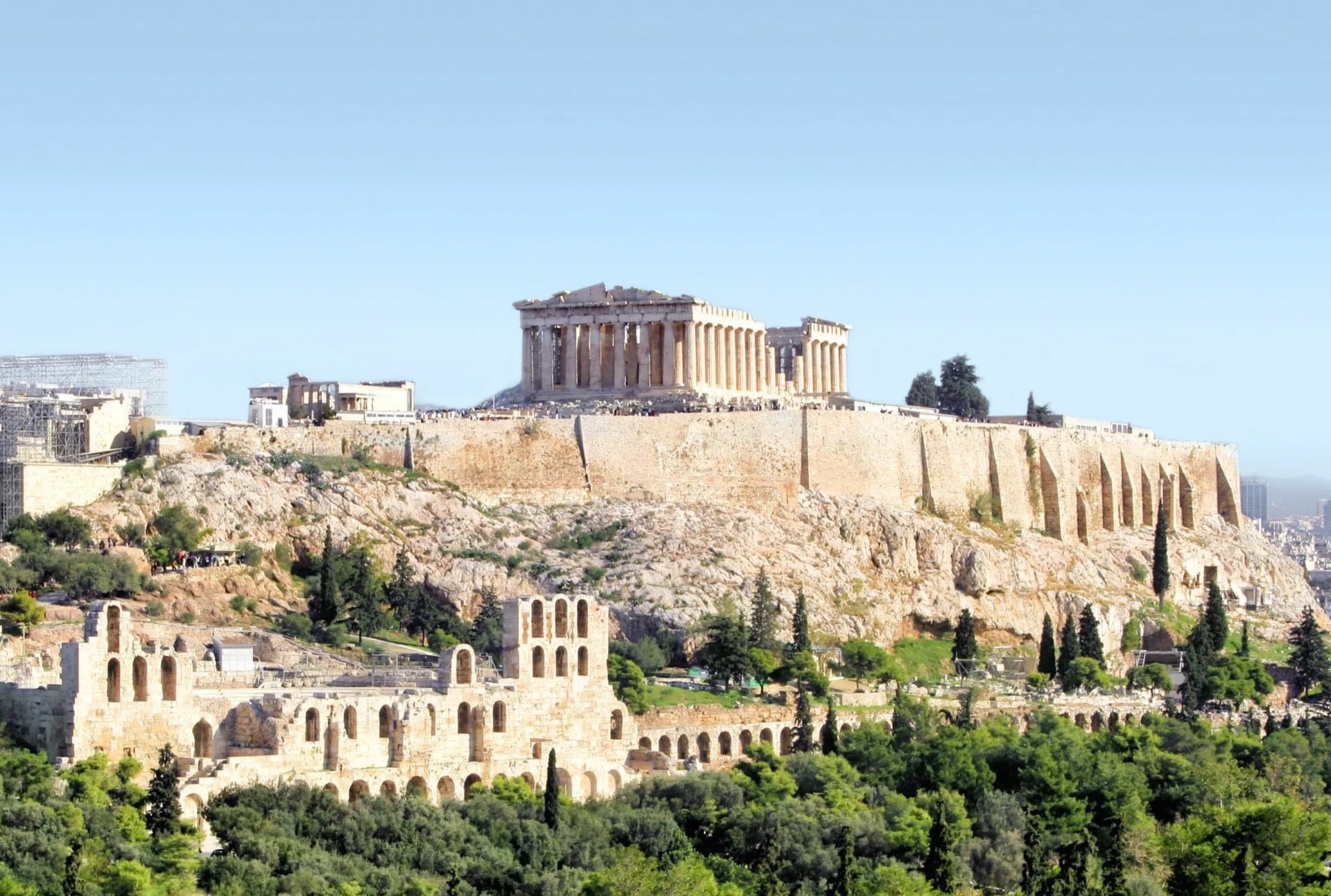
Roman Agora
Attica & Central Greece
The Roman Agora was built in the 1st c. BC with gifts from Julius Caesar and Augustus to house Athens' commercial activities. The Agora is bordered by the imposing Gate of Athena Archegetis, while the Clock of Kyrrestos with relief figures of the eight winds and the Fethiye Mosque stand at its corners.

At the south side of the Agora are preserved a krene [fountain-house] and three small edifices which probably were the offices of the commercial authorities like agoranomoi or metronomoi etc.
At the east part of the Agora on the back side of the stoa wall small rooms in the raw are opened which must be interpreted as shops. Also non permanent installations at the form of kiosks which were placed inside the stoas were also used as shops.
At he eastern part of the Agora outside now of the Archeological side there are three very important monuments which are the so-called Agoranomio, a three arched with escalator building, according to the inscription on the lintel which infers that it was dedicated to Agoranomoi and to divi Augusti, which in fact must be interpreted as the monumentalisation of the 1st century AD, of the ancient road the once lead the Diogeneion Gymnasion at the eastern part of the city. The second one is the public latrins the Vespasianae of the 1st centyry A.D. and the third most important the Horologion of Andronicus Kyrrhestus or better known as Tower of Winds.

From 1st of April until 31 of August 08:00 - 20:00
Last entrance to the Site at 19:30
On the 1st of September the opening hours apply, due to a gradual reduction in the length of the day, as follows:
1st to 15th September 08:00 - 19:30
Last entrance to the Site at 19:00
16th to 30th September 08:00 - 19:00
Last entrance to the Site at 18:30
1st to 15th October 08:00 - 18:30
Last entrance to the Site at 18:00 and
16th to 31st October 08:00 - 18:00
Last entrance to the Site at 17:30
Last entrance to the Site at 19:30
On the 1st of September the opening hours apply, due to a gradual reduction in the length of the day, as follows:
1st to 15th September 08:00 - 19:30
Last entrance to the Site at 19:00
16th to 30th September 08:00 - 19:00
Last entrance to the Site at 18:30
1st to 15th October 08:00 - 18:30
Last entrance to the Site at 18:00 and
16th to 31st October 08:00 - 18:00
Last entrance to the Site at 17:30
Click here to locate the Site on map
The Roman Agora of Athens was built at the end of the 1st century B.C. to the beginnings of the 1st century A.D. in order to facilitate some of the commercial activities of the city. The Agora building was erected probably after the donations of Julius Ceasar and Emperor Augustus. It has the form of an enclosed building with four stoas each on every side and two monumental gateways one on the east and one on the west. The better preserved west propylon is the well known Gateway of Athena Archegetis according to the inscription on the lintel which also comments that the donour of the Agora to the city was the Demos of Athens.At the south side of the Agora are preserved a krene [fountain-house] and three small edifices which probably were the offices of the commercial authorities like agoranomoi or metronomoi etc.
At the east part of the Agora on the back side of the stoa wall small rooms in the raw are opened which must be interpreted as shops. Also non permanent installations at the form of kiosks which were placed inside the stoas were also used as shops.
At he eastern part of the Agora outside now of the Archeological side there are three very important monuments which are the so-called Agoranomio, a three arched with escalator building, according to the inscription on the lintel which infers that it was dedicated to Agoranomoi and to divi Augusti, which in fact must be interpreted as the monumentalisation of the 1st century AD, of the ancient road the once lead the Diogeneion Gymnasion at the eastern part of the city. The second one is the public latrins the Vespasianae of the 1st centyry A.D. and the third most important the Horologion of Andronicus Kyrrhestus or better known as Tower of Winds.
The Archaeological Site of the Roman Agora is wheelchair accessible through the main entrance, at Dioskouron [assistance by a companion is advisable]. In the area of the Horogion of Andronicus Kyrrhestus, wheelchair access is possible through the entrance at the Pelopida Street.
The archaeological museum of the Ancient Agora is fully accessible to visitors with reduced mobility and wheelchair users. A WC for the physically challenged is also provided.
At the entrance of the site, tactile site plans and brochures in Braille in Greek and English are available for visually impaired visitors.
A guide for visitors on the autism spectrum is available at the internet site of the Ephorate: https://efaathculture.gr.
Moreover, our internet site presenting the Archaeological Sites that have been awarded the European Heritage Label http://theheartofancientathens.gr, is fully accessible to blind and partially sighted people in Greek, English, French, German, Italian and Spanish.
The archaeological museum of the Ancient Agora is fully accessible to visitors with reduced mobility and wheelchair users. A WC for the physically challenged is also provided.
At the entrance of the site, tactile site plans and brochures in Braille in Greek and English are available for visually impaired visitors.
A guide for visitors on the autism spectrum is available at the internet site of the Ephorate: https://efaathculture.gr.
Moreover, our internet site presenting the Archaeological Sites that have been awarded the European Heritage Label http://theheartofancientathens.gr, is fully accessible to blind and partially sighted people in Greek, English, French, German, Italian and Spanish.

